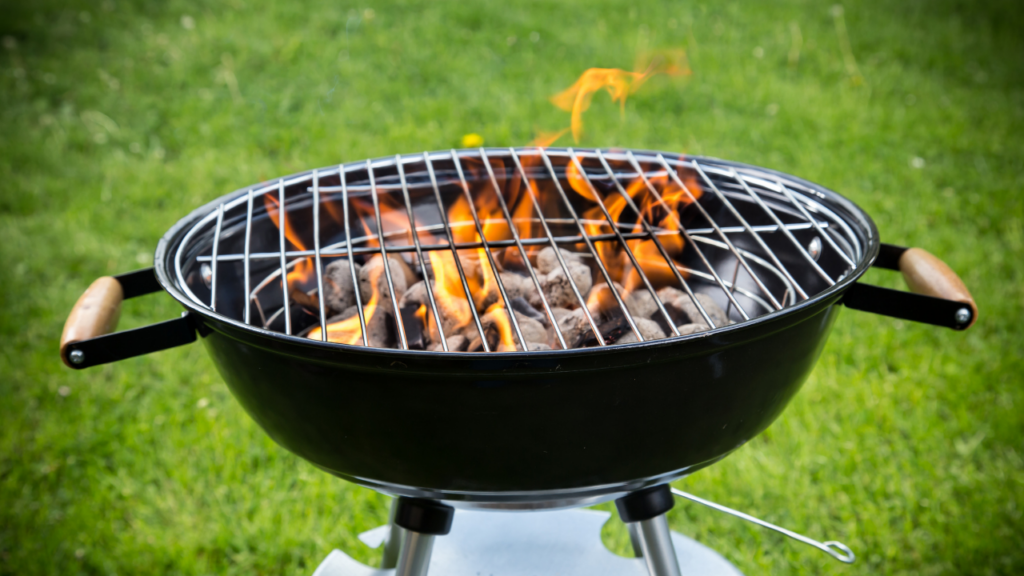Cookout and Grilling Safety Tips
go.ncsu.edu/readext?807491
en Español / em Português
El inglés es el idioma de control de esta página. En la medida en que haya algún conflicto entre la traducción al inglés y la traducción, el inglés prevalece.
Al hacer clic en el enlace de traducción se activa un servicio de traducción gratuito para convertir la página al español. Al igual que con cualquier traducción por Internet, la conversión no es sensible al contexto y puede que no traduzca el texto en su significado original. NC State Extension no garantiza la exactitud del texto traducido. Por favor, tenga en cuenta que algunas aplicaciones y/o servicios pueden no funcionar como se espera cuando se traducen.
Português
Inglês é o idioma de controle desta página. Na medida que haja algum conflito entre o texto original em Inglês e a tradução, o Inglês prevalece.
Ao clicar no link de tradução, um serviço gratuito de tradução será ativado para converter a página para o Português. Como em qualquer tradução pela internet, a conversão não é sensivel ao contexto e pode não ocorrer a tradução para o significado orginal. O serviço de Extensão da Carolina do Norte (NC State Extension) não garante a exatidão do texto traduzido. Por favor, observe que algumas funções ou serviços podem não funcionar como esperado após a tradução.
English
English is the controlling language of this page. To the extent there is any conflict between the English text and the translation, English controls.
Clicking on the translation link activates a free translation service to convert the page to Spanish. As with any Internet translation, the conversion is not context-sensitive and may not translate the text to its original meaning. NC State Extension does not guarantee the accuracy of the translated text. Please note that some applications and/or services may not function as expected when translated.
Collapse ▲Summer cookouts are fantastic for enjoying grilled food and good company. But safety’s key, especially when you’re feeding friends and family. When it comes to food, protecting people is always the first concern.
Safety Tip #1
Wash your hands before you start handling food with warm, soapy water. Make sure to wash your hands for at least 20 seconds, which is the equivalent of singing Happy Birthday twice (not the Stevie version, lol!).
Safety Tip #2
Controlling the fire is essential for safe grilling. Your top priority is to keep the flames confined within the grill itself. Always position your grill in an open space, clear of anything overhead like trees or parts of your home. It’s also important to keep your grill clean. Regularly remove fat drippings and food debris, as these can easily cause dangerous flare-ups that char your food. After you’ve finished cooking, always ensure your heat source is completely off.
Safety Tip #3
Grill grates collect debris and old food. Always clean them before and after each use. Follow the manufacturer’s instructions, use a store-bought cleaner, or try a natural mix of white vinegar, baking soda, and steel wool to remove grime.
Safety Tip #4
Clean utensils, plates, and other dishes with hot, soapy water. You can keep utensils clean and reduce the risk of cross-contamination by assigning certain utensils and dishes a purpose/assignment. You can propose some for raw foods and another set for cooked and ready-to-eat foods.
Safety Tip #5
For food safety, always cook foods to their proper internal temperature. This is how you reduce pathogens to a safe level. Don’t rely on how food looks or its juices; always use a food thermometer. When serving, keep hot foods at 135°F (57°C) or above, and cold foods at 41°F (5°C) or below. If you’re not serving food immediately, refrigerate it to keep it cold.
- 135°F: Commercially processed, fully cooked foods such as hot dogs
- 145ºF: Whole cuts of beef, pork, veal, lamb, and fish.
- 155ºF: Ground/tenderized meats
- 165ºF: Poultry (ground or whole)
- *Opaque in Color*: Shrimp, crab, crawfish, scallops, and lobster.
Safety Tip #6
Cooling and storing foods properly. Make sure to cool hot food down to 41ºF within at least six hours. Cool food from 135ºF to 70ºF within two hours. Cool from 70ºF to 41ºF within four hours. Store food in a refrigerator that is 41ºF or below.
Fun Tips
Fun Tip #1
Get the whole family involved in grilling. Let children help with tasks that they find fun and that they are able to do. Have them measure food out. Children can be excellent runners in order to take food to and from the grill.
Fun Tip #2
Mix it up and try grilling veggies and fruits on the grill, such as pineapple, peaches, zucchini, yellow squash, etc. This is a great way to get a few servings of fruits or veggies in your diet.
Fun Tip #3
Set up the environment for a fun time of being outside with the grill. Set up games such as cornhole, ring toss, spike ball, or horseshoes. You can also set up outside dining. Make sure to use a safe insect/mosquito repellent.
If you would like more resources, please check out the following.





